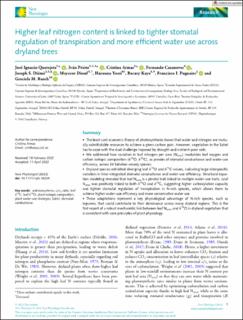Higher leaf nitrogen content is linked to tighter stomatalregulation of transpiration and more efficient water use acrossdryland trees
Querejeta, José Ignacio; Prieto, Ivan; Armas, Cristina; Casanoves, Fernando; Diémé, Joseph S.; Diouf, Mayécor; Yossi, Harouna; Kaya, Bocary; Pugnaire, Francisco I.; Rusch, Graciela
Peer reviewed, Journal article
Published version

Åpne
Permanent lenke
https://hdl.handle.net/11250/3001418Utgivelsesdato
2022Metadata
Vis full innførselSamlinger
- Publikasjoner fra CRIStin - NINA [2364]
- Scientific publications [1392]
Originalversjon
10.1111/nph.18254Sammendrag
The least-cost economic theory of photosynthesis shows that water and nitrogen are mutu-ally substitutable resources to achieve a given carbon gain. However, vegetation in the Sahelhas to cope with the dual challenge imposed by drought and nutrient-poor soils.We addressed how variation in leaf nitrogen per area (Narea) modulates leaf oxygen andcarbon isotopic composition (δ18O,δ13C), as proxies of stomatal conductance and water-useefficiency, across 34 Sahelian woody species.Dryland species exhibited diverging leafδ18O andδ13C values, indicating large interspecificvariation in time-integrated stomatal conductance and water-use efficiency. Structural equa-tion modeling revealed that leaf Nareais a pivotal trait linked to multiple water-use traits. LeafNareawas positively linked to bothδ18O andδ13C, suggesting higher carboxylation capacityand tighter stomatal regulation of transpiration in N-rich species, which allows them toachieve higher water-use efficiency and more conservative water use.These adaptations represent a key physiological advantage of N-rich species, such aslegumes, that could contribute to their dominance across many dryland regions. This is thefirst report of a robust mechanistic link between leaf Nareaandδ18O in dryland vegetation that is consistent with core principles of plant physiology. δ13C, leafδ18O, plant isotopic composition,plant water-use strategies, Sahel, stomatalconductance
